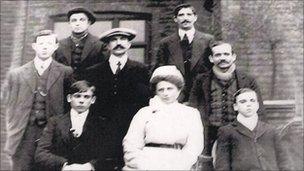Senghenydd marks mine tragedy that killed hundreds
- Published

Fifteen days after the 1913 explosion, rescuers found 18 men and boys alive
The relief at Chile's mine rescue has captured the world's imagination and underlined the dangers facing those who work underground.
One tiny south Wales community - the Aber valley in Caerphilly county - has long lived with the risks and on Thursday is coming together for a service to remember two tragedies.
More than 500 men and boys died in 1901 and 1913 at the Universal Colliery in Senghenydd.
The second explosion, on 14 October 1913, was to remain the UK's worst pit disaster of the 20th Century, killing 439 miners trapped in three mines.
That blast was so powerful that it threw a two-ton pit cage back up the shaft with such force that it decapitated the man overseeing the winding gear.
The funerals were held until the middle of November while rescuers were still finding men alive days later.
On day 15 of the rescue 18 men were found but they were to be the last of the 950 who had descended on the morning of the disaster.
And the struggle to save lives claimed its own casualties. One of the rescuers also died, taking the death toll to 440.
William Harris was the sole survivor of the 1901 explosion
The even greater tragedy is that men and boys died in 1913 because lessons had not been learnt - or recommendations fully implemented - from the 1901 explosion which killed 81 of the 82 miners underground at the time.
Senghenydd, even by mining standards, was a hot, dry and dusty pit. And dust can create its own blast once it has been set off by an explosion or spark.
"That why the explosion was so bad, there was so much dust, dust creates combustion," said retired miner and former mine rescue team member Noel Snailham, 78.
"You had the explosion and the flame would carry right through and it would pick up the dust and carry on."
Mr Snailham, from Bedwas, grew up on the story of how his miner grandfather, Albert Dean, caught in the blast 97 years ago today, poured tea into his muffler or face covering to stifle the dust.
Albert then handed the muffler to the 14-year-old boy working with him. The boy lived. Albert, a 33-year-old father of four, died.
"He took his muffler off and gave it to the boy and the boy was saved. The gentleman was pointed out to me years later," said Mr Snailham.
Mr Snailham, whose mine rescue work saw him called to Aberfan, this week visited the Heritage Room in Senghenydd's community centre where Aber Valley Heritage Group has hundreds of photographs, reports and letters that throw light on the human suffering in the decades that followed the two disasters.
For even though he is from a coal mining family - at one time he worked underground with his two brothers - the 1913 tragedy was not a topic of conversation.
'Community spirit'
He said: "Mother never talked about it. She was only seven at the time."
The family's suffering was shared by many others in the community which was not much smaller than the 3,000 households in the community now.
"Everyone is aware that Senghenydd is as is today - the community spirit , the helping with the neighbours - because of what happened then," said Carol Bowen, Aber Valley Heritage Group.
"We hold a memorial service every year."
Jean Sellers, 73, is the granddaughter of William Harris, the sole survivor of the 1901 explosion.
Like Mr Snailham's family, her relatives did not discuss the blast that claimed the lives of many in the community.
Mrs Sellers said: "Once it was over that was that. It was not talked about at all. It was something that was accepted."
But the family will be attending Thursday's service to pay tribute to those who lost their lives .
Mrs Sellers, who still lives in Senghenydd, said: "I want to be pay my respects to those who died and I think that's very important. My cousin's daughter is over from Amercia and she is coming along as well with her children.
"I think people should remember what happened in the valley. "